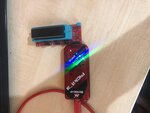spiritevil
Newbie level 4

Hello,
I use the pickit3 connected to the PIC18F4550 through target board. Each time I run Mplabx v5.15 it shows:
Device Erased...
""
Programming...
The following memory area(s) will be programmed:
program memory: start address = 0x0, end address = 0x97f
configuration memory
program memory
Address: 12 Expected Value: f0 Received Value: e0
Failed to program device
""
The Expected value and Received value never matches. I don't know if that is the problem and what causes that.
Note: I wrote my code in Mikroc then now I'm trying to upload the Hex file on the chip through Mplabx IDE
Does anyone have any idea of what could stop the chip to program?
Thanks in advance!
I use the pickit3 connected to the PIC18F4550 through target board. Each time I run Mplabx v5.15 it shows:
Device Erased...
""
Programming...
The following memory area(s) will be programmed:
program memory: start address = 0x0, end address = 0x97f
configuration memory
program memory
Address: 12 Expected Value: f0 Received Value: e0
Failed to program device
""
The Expected value and Received value never matches. I don't know if that is the problem and what causes that.
Note: I wrote my code in Mikroc then now I'm trying to upload the Hex file on the chip through Mplabx IDE
Does anyone have any idea of what could stop the chip to program?
Thanks in advance!




